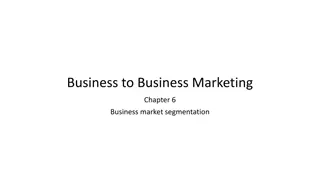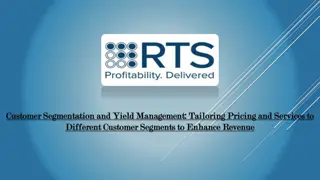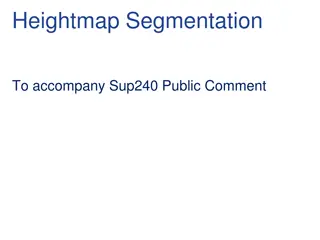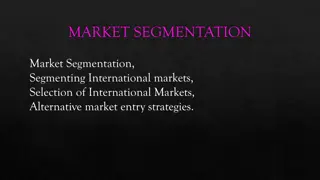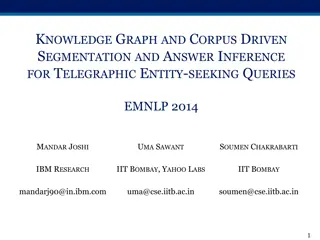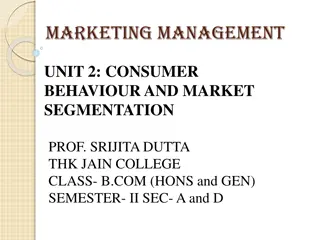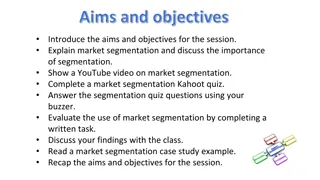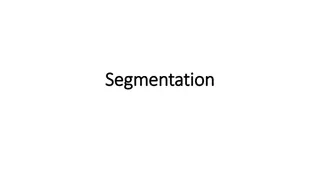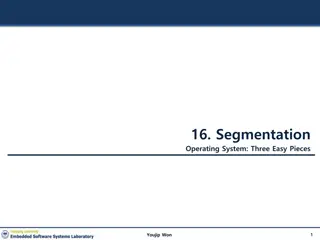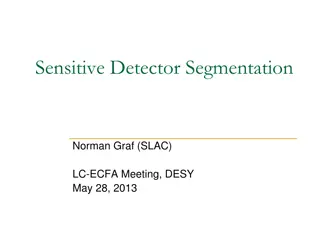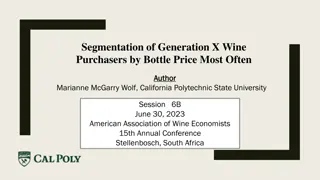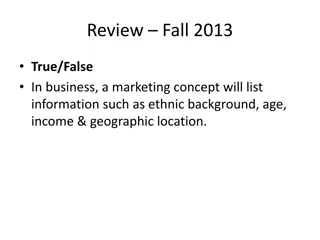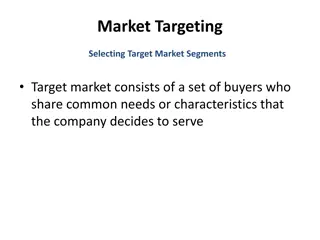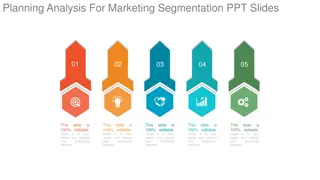Market Segmentation
Market segmentation involves breaking down potential buyers into groups to better understand their needs and behavior. By identifying market segments, businesses can tailor their products, services, and marketing strategies to target specific customer groups effectively. This approach helps in identifying opportunities for new product development, designing marketing programs to reach homogenous buyer groups, and optimizing the allocation of marketing resources. The concept of marketing segmentation emphasizes the importance of understanding and satisfying customer needs better than the competition, recognizing that different customers have unique preferences and requirements that cannot be addressed with a one-size-fits-all approach. The differences between mass and target markets lie in whether customers are treated as a homogenous group or recognized for their diversity and individual needs. To effectively segment a market, the segments must have measurable differentiating attributes, be accessible through communication and distribution channels, respond differently to marketing mixes, justify separate offerings, be large enough to justify resource allocation, and exhibit stability to minimize costs associated with frequent changes.
Download Presentation

Please find below an Image/Link to download the presentation.
The content on the website is provided AS IS for your information and personal use only. It may not be sold, licensed, or shared on other websites without obtaining consent from the author.If you encounter any issues during the download, it is possible that the publisher has removed the file from their server.
You are allowed to download the files provided on this website for personal or commercial use, subject to the condition that they are used lawfully. All files are the property of their respective owners.
The content on the website is provided AS IS for your information and personal use only. It may not be sold, licensed, or shared on other websites without obtaining consent from the author.
E N D
Presentation Transcript
Market Segmentation
What is Market Segmentation? THE BREAKING DOWN OR BUILDING UPOF POTENTIAL BUYERS INTO GROUPSCALLED MARKET SEGMENTS
Benefits of Market Segmentation Identifies opportunities for new productdevelopment Helps design marketing programs most effectivefor reaching homogenous groups ofbuyers Improves allocation of marketingresources
The need for marketing segmentation The marketing concept calls for understanding customer and satisfying there needs better than thecompetition. Different customers have different needs, and itsrarely possible to satisfy all the customers by treating them alike.
Difference between a mass and target market market Mass market refers to treatment of the market as a homogenous group and offering the samemarketing mix to all customers.
Difference between a mass and target market market Target market on the other hand recognizes the diversity of the customers and does not try to please all of them with the same offering.
Requirements of market segments Indefinable: the differentiating attributes of the segments must be measurable so they can beidentified. Accessible: the segments must be reachablethrough communication and distributionchannels.
Requirements of market segments Unique needs: to justify separate offerings, the segments must respond differently to different marketingmixes. Substantial: the segments should be sufficiently largeto justify the resources required to target them.
Requirements of market segments Durable: the segments should be relatively stable to minimize the cost of frequent changes.
Bases for segmentationin consumer markets Geographic Demographic Psychographic Behavioralistic
Geographicsegmentation Geographic segmentation tries to divide markets into different geographicalunits: Regions Size of the area Population density Climate
Geographicsegmentation Regions: by continent, country, stateor even neighborhood Size of the area: segmentedaccording to size of population
Geographicsegmentation Population density: often classifiedas urban, suburban, or rural Climate: according to weather patterns common to certain geographicregions
Demographic segmentation Demographic segmentation consists of dividing the market into groups based on variables suchas: Age Gender Income Socialclass Life style
Demographic segmentation Age : Marketers design, package and promote products differently to meet the wants of different agegroups. Good examples include the marketing of toothpaste (contrast the branding of toothpaste for children and adults) and toys (with many age-basedsegments).
Demographic segmentation Gender: Gender segmentation is widely used in consumer marketing. The best examples include clothing, hairdressing, magazines and toiletries andcosmetics.
Demographic segmentation Income: Many companies target affluent consumers withluxury goods and convenience services. Good examples include Coutts bank; Moet & Chandon champagne and Elegant Resorts - an up-market travelcompany.
Demographic segmentation Social class: Consumers "perceived" social class influences their preferences for cars, clothes,home furnishings, leisure activities and other products & services.
Demographic segmentation Lifestyle: Marketers are increasingly interested in the effect of consumer "lifestyles" on demand. Unfortunately, there are many different lifestyle categorization systems, many of them designed by advertising and marketing agencies as a way of winning new marketing clients andcampaigns.
Psychographic segmentation Psychographic segmentation groups customers according to their lifestyle. Activities, interest, and opinions (AIO) surveys are one tool for measuringlifestyle. Activities Interest Opinion Values
Behavioralistic segmentation Behavioralistic segmentation is based on actual customer behavior towards products. Some behavioralistic variable include: Opinions, interests and hobbies Degree of loyalty Occasions Benefits sought Usage
Behavioralistic segmentation Opinions, interests and hobbies this covers a huge area and includes consumers political opinions, views on the environment, sporting and recreational activities and arts and cultural issues.
Behavioralistic segmentation Degree of loyalty customers who buy one brand either all or most of the time are valuable tofirms.
Behavioralistic segmentation Occasions this segments on the basis of when a product is purchased or consumed.
Behavioralistic segmentation Benefits sought this requires marketers to identify and understand the main benefits consumers look for in a product. Usage some markets can be segmented into light, medium and heavy usergroups.
Definition : Target market is a business term meaning the market segment to which a particular good or service is marketed. It is mainly defined by age, gender, geography, socio-economic grouping, or any other combination of demographics. 27
Target market is defined in terms of : o Demographic segmentation o Geographic segmentation o Psychographic segmentation o Behavioural segmentation 28
Demographic segmentation : The demographic segmentation divides customers into segments based on demographic values such as age, gender, family size, family life cycle, occupation, education,religion, generation, social class and nationality. 29
a. Age and life-cycle segmentation: The consumer s needs and wants change with age. Therefore some companies use age and life- cycle segmentation, where age and the life-cycledetermine the marketingapproach. 30
b. Gender segmentation: Gender segmentation is used to differentiatethe needs and wants between men and women due to the fact that men and women have different attitudes toward aproduct. 31
Income segmentation: c. Income segmentation divides the market into income groups. It is used in automobiles, clothing, cosmetics, and travel. different 32
d. Generation segmentation: Each generation is influenced by the times in which they grow up for example the music, the movies, politics and other significant events characteristic of that period. 33
e. Social Class segmentation Social class segmentation divides the customers according to their preferences in cars, clothing, home furnishings, leisure activities, reading habits. 34
Geographic segmentation The geographic segmentation divides customers into segments based ongeographical areas such as nations, states, regions, countries, cities. 35
Psychographic segmentation The psychological variables derive from two principal types of customer: personality profiles and lifestyleprofiles. 36
Behavioural segmentation Behavioural segmentation is based on the customers attitude toward, use of, orresponse to aproduct. 37
Technographic Segmentation: This type of segmentation differentiates people based on technology they use. With technology becoming such an ingrained part of our lives, technographic segmentation becomes all themore important. 38
Decisions involved in targeting, including strategy : which segments totargeting. how many products tooffer. which products to offer in whichsegments. 39
Targeting strategy decisions are influenced by: Market maturity. Diversity of buyers' needs and preferences. Strength of the competition. The volume of sales required forprofitability. 40
Target MarketStrategies 1. Concentrated strategy (Single-segment strategy). One market segment (not the entire market). Asingle- segment approach often is the strategy of choice for smaller companies with limited resources. 41
2. Differentiated strategy (Selective specialization or multiple-segment strategy) : Different marketing mixes are offered to different segments. The product it self may or may not be different - in many cases only the promotional message or distribution channels vary. 42
Product specialization. The firm specializes in a particular product and tailors it to different market segments. 43
Exemples Desert Coolers : If your company is sellingdesert coolers, it is obvious that the target market will be extremely in hot regions of the world and not the cold ones. 44
Baby Products: Marketers selling baby products have to segment their market in terms of age group, but they alsohave to consider pyschographic segmentation, because sales will depend on the lifestyle of the parents. If the parents have a lavish lifestyle, they will agree to spend money on expensive babyproducts. 45
Cosmetics: Cosmetics are gender-based, exclusively for menor women, thus, segmentation based on gender will have to be done. However, just dividing the market on the basis of gender is not enough. Lifestyles of men and women come into play, because cosmetics come in all ranges and thus depending on the cost of the product, it will require psychographic and behavioral segmentation. 46
o Results of wrong targeting strategy o Ineffective augmentation and targeting led to wrong productoffers, o inappropriate marketing appeals wrong pricing No firm can offer single productto satisfy all the segment. 47












